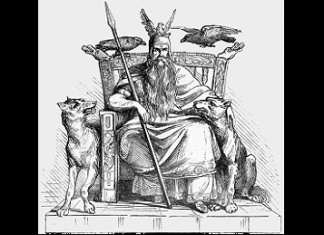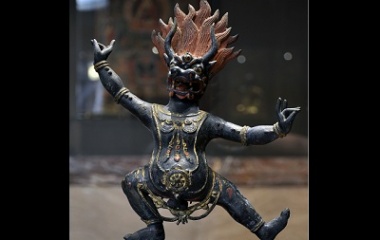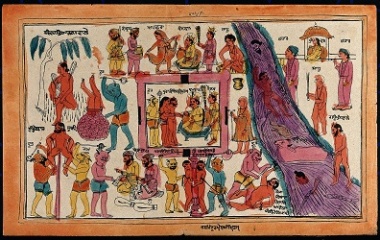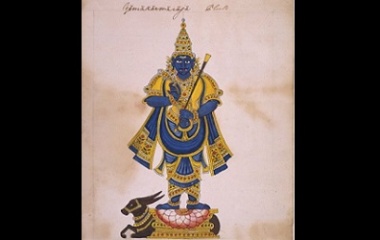- Pronunciation: YA-ma
- Origin: India
- Role: God of death
- Parents: Saranyu and Vivasvant
- Twin: Yami
Who Is Yama?
According to the Vedas, the ancient Hindu texts, there is a “Book of Destiny” where the records of each person’s lifetime deeds are recorded. It is Yama, the god of death, who determines the justice that each soul will receive, and their path after they die. It is believed that Yama was the very first human to die, which is why he has the task of presiding over where the dead will rest. He is also referred to as Dharma, which roughly translated means cosmic order, as he is dedicated to keeping harmony.
The name Yama means twin in Vedic Sanskrit, and in some of the Hindu myths he has a twin sister named Yami, who is the mother goddess. They are two of the most ancient deities, and considered very wise; however, their standing is below the Lord Shiva and the Lord Vishnu, the ultimate gods.
Origin
While the exact origin of Yama isn’t clear, he was at one time mortal, so he is familiar with how it feels to live and to die as a human. Even though he is a feared deity, due to his ability to decide whether people go to heaven or hell, he is also known to be empathetic and compassionate as he applies justice. He only inflicts punishment on the wicked, and is considered a friend of humanity.
Yama lives in a palace in a place named Kalichi, which is located within Patala, the underworld in Hindi, and the regions located below the earth. Yama is depicted with green skin. He wears red clothing and a shining crown with a flower in it and rides a buffalo. Sometimes he has two arms, while in other representations he has four. He is often shown carrying a noose which he uses to catch people. It is no wonder he was feared.
Keeping records of the deeds of all mankind is a daunting task, so Yama had several assistants. The most notable is Chitragupta, who keeps the book that records the deeds of mankind. He reads from the book about the virtues and sins of the dead person’s soul and the god of death decides their fate. The best people are allowed to enter Pitris, which is Hindu heaven. The bad souls end up in one of the many hells, and those who are moderate are sent back to earth to work at getting another shot at Pitris, where if they are lucky they will be reunited with their ancestors. No matter what their destiny, most Hindus are not too keen on the idea of dying and have devised numerous ways of avoiding Yama.
It was told that to avoid being summoned by the god of death, you could chant the names of the triad of supreme gods, Brahma, Vishnu and Shiva. This wasn’t too effective as it’s not possible to spend a lifetime chanting names, so Hindus do die. There were, however, occasions where it was said to have worked.
Markandeya, a very spiritual man, and devoted to the god of Shiva, was always praying and staying near the linga. A linga is a phallic symbol that is the idol representation of the god Shiva’s genitals, also known as Shiva Linga. Despite his devotion, his days were numbered as he was getting older and it was already determined in the book of destiny that he had just a few years left to live. Yama came to summon him but faced a terrible dilemma as the guy was always praying at Shiva Linga. Finally, Yama took out his lasso to rope Markandeya, but the guy just wouldn’t let go of the linga, so he was dragging both the man and the statue together back to Kalichi. The supreme deity Shiva saw what was happening and became furious. He actually kicked Yama to death, and his spiritual devotee was saved.
That may sound like a neat ending, but what happened next was a huge problem. Now that Yama was dead, everyone else was immortal. No one died on earth anymore, so everywhere became overcrowded. On top of that, since no one was afraid of death, everyone was just doing as they wished and the concept of sin no longer existed. As you can imagine, the situation was quite chaotic. The gods held a meeting, and Lord Shiva agreed to bring Yama back to life so he could resume his position. Once again, people had to go back to whispering the names of the triad to ward off the god of death and trying to behave in a virtuous manner to seal a better fate for themselves for when he did catch up with them.
Family of Yama
The father of Yama is Vivasvant, the god of the rising sun, and his mother is Saranyu, the goddess of the clouds. Yami is his twin sister, and in some stories also his wife. Since Yama was the first man to die, which he volunteered for according to the legend, his devoted twin was left heartbroken and grieving so badly that the gods came to assist her, but found she was inconsolable. To cure her of misery, they created the nighttime. For all eternity going forward, the night would follow the day and time would help to heal grief.
The precise derivation of the expression “time heals all wounds” is uncertain, but the lesson follows the story of Yama and Yami.
Historic Influence
In the ancient Vedic texts of Hinduism, people were judged by Yama in accordance with their deeds and duties during their lifetime. The concept of karma equates to predicting a person’s fate and their destined existence in their next life when they are reincarnated, which is another fundamental Hindu belief. Both karma and reincarnation are directly tied to the judgement of Yama and form the origins of the original caste system.
During the time in between lives, souls who were judged as virtuous spent their time in heaven, and when they were born, it was to a higher class. Souls who didn’t perform on earth were punished in various levels of hell and were reborn into lower classes. A person’s caste was determined by their birth and there was no way to alter it during the current lifetime.
Although this system has evolved through the centuries, and the concept of untouchables, the lowest class, was outlawed in the 1950s, the system still has an influence on modern society in India today. The updated version is seemingly classified by socioeconomic distinction, and familial pressure for marriage within the parameters of similar financial and educational backgrounds. Although there is currently upward social mobility in India, a person’s last name is still an identifier of caste. Even those who change their names are required to keep their original name for certain legal transactions or school transcripts, so there is still no permanent eraser of birthright, even among the most highly educated members of the lower classes.










